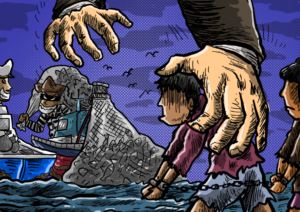Nibras Nada Nailufar will never forget the events that happened on Tuesday, September 24, 2019. She was in charge of covering the demonstration against the bill of General Code of Criminal Law (RKUHP) and the Omnibus Law or the Job Creation Act in front of the House of Representatives (DPR) building in Senayan, Jakarta.
The rejection was carried out by various elements of society, such as workers, activists and students. “I was there for the special coverage. I only took data and pictures,” said Nibras, telling the story of three years ago when contacted by Jaring.id by telephone on Thursday, October 26, 2022.
The mass action against the draft regulations did not only occur in Jakarta, but also in a number of big cities in Indonesia, including Yogyakarta, Malang, Medan, and Kendari. Most of the protests ended in chaos, as clashes happened between the protesters and the police. In Jakarta, Nibras saw with her own eyes how the police carried out acts of violence against the masses. “The atmosphere was tense,” she said.
The police did not hesitate to beat, kick, strip, and drag a number of people to the Jakarta Convention Center (JCC)—the building next to the parliament office. This building was previously used as a gathering point for the police who were tasked with dispelling the masses from entering the Senayan area.
Nibras, who saw the incident, tried to remind the police not to be arbitrary while aiming to take video of the police with her camera. This Kompas.com journalist kept recording but then she was surrounded by a number of police who yelled at her. “The uniformed police asked me to stop recording,” she said.
Of course she refused to bow with the police. As a journalist, Nibras needs to tell the public about the brutality of the police. But the police insisted on taking her cell phone, even though they had read her press ID card. “I ended up putting (the phone) in my bra. As soon as (the police) came to me, I put my cell phone in my bra. But they tried to pull my hand and pull my bag,” she recalled.
Nibras then reported the incident to her editor. The Alliance of Independent Journalists (AJI) and the Legal Aid Institute (LBH) for the Press were also contacted to report cases of violence they experienced to the police. “I am afraid that if something happens, the police will sue me, so I need assistance,” she said.
The report was filed by Nibras with her attorney from LBH Pers to the Integrated Police Service Center (SPKT) of the Jakarta Police two weeks after the incident. However, the report was rejected. The reason, she said, was that the alleged perpetrators of the violence were the police. The police suggested that the complaint be submitted to the Profession and Security Division (Propam) of the Jakarta Police.
Nibras refused it, because she deliberately wanted the report to be processed as a criminal case because it was against the law. The police have hindered the work of journalists as stated in the Press Law Number 40 of 1999. “We managed to report it after we talked to our fellow journalists. Finally, my fellows helped me file a report to the Head of Public Relations of the Regional Police. Then the report is received at the SPKT,” she explained.
The Jakarta Police handed over the Nibras case to the Central Jakarta Resort Police. However, the investigation process took a long time. From complaints to summons, it took up to three months. “After that, I was summoned and asked for information as a reporter,” she said.
Three years have passed, and the case of violence Nibras experienced has not been completed. She had repeatedly asked the police about the progress of the case. But until now, there is no legal certainty.
Tempo’s journalist, Nurhadi, also experienced violence when he was doing investigative coverage. On Saturday night, March 27, 2021, Nurhadi was assigned to confirm allegations of corruption by the former Director of Audit and Collection of the Directorate General of Taxes, Angin Prayitno Aji. Tempo magazine wants to write a report regarding bribes of Rp 15 billion and US$4 million, or around Rp. 42.17 billion, related to three tax audits at PT Gunung Madu Plantations, PT Bank Pan Indonesia Tbk, and PT Jhonlin Baratama.
Nurhadi asked a videographer to go with him to take a picture of Angin, who was holding his son’s wedding celebration with the son of one of the top police officers at Graha Muda Samudra, Indonesian Navy Complex, Surabaya, East Java. However, it was not easy for Nurhadi to enter the party venue because it was an exclusive event. Guests must bring barcoded invitations that have been prepared by the organizer. Guests are also prohibited from documenting the wedding party. The reason, at that time, was because the wedding was held in the midst of the Covid-19 outbreak.
“I ended up entering the venue through the side door. I didn’t know that there was a prohibition on documenting,” recalled Nurhadi on Thursday, October 26, 2022. Nurhadi took three pictures of the wedding atmosphere, including the figure of Angin. The image was then sent to the editor of Tempo Magazine. Shortly after taking the pictures, Nurhadi was followed by two people. “They took a picture of me,” he said. Nurhadi also took a photo of the two people. Then report to the Tempo Magazine editor. “They stalked me. The two people who were dressed in batik,” continued Nurhadi.
In less than five minutes, the people who followed Nurhadi pushed him to the side door of the building—where Nurhadi entered the wedding venue. There, he began to be interrogated. Nurhadi tried to pretend that he was a guest of the bride. The family of the bride was called and said that they did not know Nurhadi. Feeling pressured, the man from Tuban finally admitted that he was from Tempo. “They were upset. My cell phone was confiscated. After that, I was pinned. They tried to hit me, but I dodged and then they took me out,” said Nurhadi.
Nurhadi was taken to the Tanjung Perak Police Station for questioning on the grounds of making a fuss. However, in less than ten minutes, the officer who brought Nurhadi was asked to return to Graha Muda Samudera. Arriving at the wedding venue, dozens of people dressed in batik, police uniforms, and black suits beat him together. “Getting out of the car, I was beaten and strangled,” he said.
To prevent any commotion in the wedding area, Nurhadi was taken to a warehouse which was transformed into a place for officers to rest, as well as a place to change clothes. Nurhadi was relieved for a moment, thinking that he would not be subjected to violence again. But when he was just sitting on a chair, another punch flew to his face. After that, his face was covered with red plastic. “I was beaten and interrogated. I spoke as necessary. Then I asked my colleague to come,” said Nurhadi.
The police officers repeatedly asked him to open his cell phone, but he refused. Not obeying the order, Nurhadi was slapped repeatedly. Feeling pressured, Nurhadi finally surrendered. “My SIM Card and SD Card were destroyed and reformatted. They also broke my cell phone,” he said.
Not only being tortured, Nurhadi was also threatened. “I was given a choice, either to be admitted to the Intensive Care Unit (ICU) or to be buried,” he said. One of the dozens of people who tortured him even said that Nurhadi should have been drowned into the sea with his legs tied. “They even threatened me like that,” he said.
After the wedding ceremony was completed, at around 11.00 p.m, Nurhadi was taken to a hotel not far from the venue. From there, he was asked to contact Tempo Magazine editors with a guarantee that the weekly magazine would not publish the photos he sent to the editor. “They are afraid that the photo will be published,” said Nurhadi.
After talking to Tempo Magazine editors, Nurhadi was finally escorted back to his house at 1.30 a.m. Arriving at home, Nurhadi borrowed his wife’s phone, then contacted the editor of Tempo via Instagram. The next morning, Tempo editorial members held a meeting and decided to provide protection and security to Nurhadi.
“I was picked up by the companion team, brought a backpack of T-shirts, and was taken to a safe house with my wife. Around 2 p.m the next day, we reported to the Police. The police’s sub-directorate head accepted the report. Then they examined my injuries (visum et repertum),” said Nurhadi.
The report was addressed to the Integrated Police Service Center at the East Java Regional Police, Jalan Ahmad Yani Surabaya on Sunday, March 28, 2021 with the report number TBL-B/176/III/RES.1.6./2021/UM/SPKT East Java Police. Nurhadi reported a police officer named Purwanto and a number of others with Article 170 of the Criminal Code and/or Article 351 of the Criminal Code and/or Article 335 of the Criminal Code and/or Article 18 of Press Law Number 40 of 1999.
Two months later, in May 2021, the East Java Regional Police named two suspects in the case of violence against Nurhadi, including Purwanto and Muhammad Firman Subkhi who are members of the police at the East Java Regional Police. Despite being suspects, the Prosecutor’s Office did not arrest the two people.
The Surabaya District Court judges sentenced Purwanto and Firman to 10 months in prison on January 12, 2022, or eight months later. The verdict was read in the Chakra Room. In addition to imprisonment, the defendant was also subject to restitution of Rp. 13,890,000 to Nurhadi, as well as a key witness with the initials F of Rp. 21,850,000. “The defendant is proven legally and convincingly to have committed a press crime as in the first indictment,” said Chief Justice Muhammad Basir on Wednesday, January 12, 2022.
Purwanto then appealed the decision. The result of the appeal decision at the East Java High Court found them guilty, but the sentence was reduced to eight months. Currently, the legal process is in the cassation stage at the Supreme Court.
Digital Attacks on the Rise
The cases of Nibras and Nurhadi are examples of violence experienced by journalists in Indonesia. Since 2019-2022, the Indonesian Alliance of Independent Journalists (AJI) has recorded hundreds of cases against journalists. In 2019, there were at least 59 incidents.
Chairman of AJI Indonesia, Sasmito Madrim, explained that the number of journalistic violence three years ago skyrocketed when riots occurred on May 20-21 in front of the Election Supervisory Body (Bawaslu) building. At that time, the mass demonstrations claiming to be the People’s Sovereignty National Action Movement rejected the announcement of Jokowi-Ma’ruf Amin as the newly elected President-Vice President for the 2019-2024 period.
A year later, the number increased to 84 cases. These dozens of cases mostly occurred when the public rejected the revisions to the Corruption Eradication Commission (KPK) Law, the Omnibus Law, and the RKUHP. In 2021, the number decreased to 42 cases. Meanwhile, from January to October 2022, there have been 39 cases.
“The reason of violence is related to in-depth coverage or writings that are critical to the government. Most of the cases happen because they (officials) don’t like the news or feel aggrieved by the news,” said Sasmito on Wednesday, October 25, 2022.
AJI Indonesia observes an increasing trend of cases of violence against journalists occurring in cyberspace. He gave an example of the hacking case experienced by 37 Narasi TV employees. Not only that, the Narasi TV website was also hacked. AJI Indonesia and the Press Legal Aid Institute reported the incident to the Police with a complaint numbered LP/B/0573/IX/2020/SPKT/BARESKRIM Polri on September 30, 2022. “Digital attacks on journalists are becoming very dominant today, exceeding physical attacks,” said Sasmito.
According to Sasmito, a lot of cases of violence occurred before the election year. “This is dangerous. The motive is mostly related to political activities, and it’s possible there will be more cases as we are getting closer to the 2024 elections.”
The perpetrators of violence are still dominated by the police. AJI noted that during 2006-2022, the number of violence committed by police officers to journalists was 61. There were also 60 cases of violence committed by the mass, and 53 cases by unknown people. A number of cases have actually been reported to the police. Unfortunately, until now, not many cases of violence against journalists have been responded to. According to AJI, it proves that the police are not serious in resolving the cases in which the victims are journalists. “Most of the other cases are stuck. So this proves that there are problems within the Indonesian National Police that must be reformed,” said Sasmito.
Similarly, LBH Pers received many complaints of violence against journalists. The cases received were mostly related to doxing, hacking, and labeling of hoaxes in media coverage. LBH Pers’s lawyer, Mustofa Layung, said that the labeling of hoaxes by the police had occurred in 2021. The victims were Project Multatuli and Republika media. “It is the Press Council’s authority to judge whether a news article is a hoax or not. It is not the police’s authority. So we noted that the attacks are increasingly varied,” said Mustofa on Wednesday, October 25, 2022.
Meanwhile, until October 2022, LBH Pers recorded three cases that had been reported to the police. Previously, there were four cases in 2020 and eight cases in 2019. All reported cases relate to journalistic work obstruction, intimidation, and physical violence. “We have even reported it to the Propam section. However, until now, there has been no progress on all the reports,” he said.
“It is quite unfortunate that some of these cases did not go further. We hope that the police will provide good service by continuing the stalled case,” said Mustofa.
Regarding the stalled reporting, Jaring.id has tried to contact the Chief of the Indonesian National Police, General Listyo Sigit via Whatsapp. But there was no reply until this article was published. Meanwhile, the Head of the Public Information Section at the National Police Headquarters, Sr. Comr. Nurul Azizah, said that the development of cases involving journalists should be asked directly to the respective regional police. “Please confirm to the police station where the report was filed, because we have not been confirmed about the case,” said Nurul via Whatsapp message on Thursday, October 27, 2022.
Until this news was published, Jaring.id had confirmed the stagnation of reports of violence against journalists to the Spokesperson of the Jakarta Police, Sr. Comr. Endra Zulvan, but there was no reply. Phone calls were not answered.
The Task Force of Violence against Journalists
Responding to the many cases of violence in the digital realm against journalists, the Press Council formed a Violence Task Force. The Press Council considers the current attacks on journalists and media to be quite worrying. If this is not handled quickly, it will threaten press freedom in Indonesia. The cases of Narasi TV, Tirto, and Tempo, as well as reports of violence against other journalists are more than enough for the Press Council to address this issue.
“If you look at the pattern of digital attacks, it is related to journalistic products that come out viral. We suspect the attack has something to do with the news. Digital attacks are a form of terror,” said Head of the Press Council Complaints Division, Arif Zulkifli on Friday, October 28, 2022.
The Press Council, he said, would oversee the legal process filed by journalists. “In addition, the council will be coordinating with stakeholders to prevent similar violence to from occurring,” said the man who is familiarly called Azul on Friday, October 28, 2022.
The Press Council predicts that cases of attacks, both physical and digital, will increase ahead of the 2024 General Election. Azul is worried that if digital attacks continue and become terror against journalists and media, there is a possibility that the media or journalists will self-censorship. “The principle of playing it safe is very dangerous for press freedom,” he said.
Azul’s concern is well-founded. In Thailand, this act of self-censorship by the media has already occurred. Senior journalist Pravit Rojanaphruk said acts of violence against journalists were almost non-existent because the majority of mainstream media in Thailand practiced self-censorship.
The mass media in Thailand do not dare to deliver news criticizing the institution of the monarchy or the kingdom. Even though political parties such as the Move Forward Party, the second largest opposition party in Thailand, have openly campaigned for monarchy reform ahead of the 2023 general election, but they don’t want to see and don’t want to mention that their self-censorship is a problem,” said Pravit to Jaring.id, Monday, October 24, 2022.
To anticipate the Indonesian press from falling into the choice of “playing it safe,” Azul said that the Press Council had taken a number of steps, including holding a meeting with representatives of the Ministry of Political, Legal and Security Affairs, the Criminal Investigation Unit of the National Police, and members of the Presidential Staff Office (KSP) to discuss issues related to security problem of violence, both physical and digital, faced by the media and journalists. “In the near future, we will be working closer with related institutions,” he said.
In addition, the Press Council also wants to renew its Memorandum of Understanding (MoU) with the Police. Based on the MoU, the Press Council wants to ensure that press disputes are resolved through the Press Council. “The rules must be detailed as to what law enforcers must do at the regional level. Then at the end of the activity, we do dissemination,” said Azul.
The last step, the Press Council has developed guidelines for the use of social media for press companies. This rule applies to media that have legal entities in accordance with the Press Law Number 40 of 1999 concerning the Press. Arif said, this guideline stipulates that the media must list all social media channels on their website and the social media accounts of the media concerned must include the official name of the media. “The guidelines have been made. It was approved in plenary. It’s just a matter of outreach to the public,” he said.
Threat against Press Freedom
The rise of cases of violence against journalists is one indicator of the low freedom of the press in Indonesia. This resulted in the Press Freedom Index dropping from a score of 62.60 in 2021 to 49.27 in 2022. Reporters Without Borders (RSF) in its report also stated that Indonesia was ranked 117th out of 180 countries, decreasing from 113rd in 2021.
Some of the things that RSF notes are that the promise of Indonesian President Joko Widodo to open press freedom in Papua has not been implemented. Another problem is the threat of criminal prosecution of journalists under the Electronic Information and Transaction Law.
In Southeast Asian countries, Indonesia’s press freedom index is still below Thailand (50.15 points), Malaysia (51.55 points), and Timor Leste (81.89 points). Conditions in Malaysia are not as bad as in Indonesia. This was conveyed by a member of the Free Media Movement (GeramM), an organization of journalists’ groups in Malaysia, Alya Alhajri. He said that the issue of violence against journalists was rare. “Malaysia does not have physical violence cases as extreme as Indonesia, the Philippines or Myanmar. It’s more about online cases at this time. It’s not as brutal as in the Philippines,” said Alya when contacted by telephone on Thursday, October 27, 2022.
According to Alya, the current cases of attacks on journalists in Malaysia, according to Alya, are stalking, doxing, and online gender-based violence. “During the pandemic, a lot of people used live (live broadcasts). People have a lot of sexual comments on the live. There are many digital attacks like that,” said Alya.
Meanwhile, the election case only happened in 2018. At that time, the national media in Malaysia reported on the incident of a member of the Malaysian House of Representatives who was in Sabah. This is related to the figure of a board member who is considered problematic. The council member was upset when he read the news and when he learned that the journalist who wrote the report was in charge of the parliament building, he immediately kicked him out. “This was the only case that is related to elections,” said Alya.
However, women who work in Malaysia today are still worried about press freedom in Malaysia. One of them is because in the neighboring country there are still laws that silence freedom of opinion and the press. One of the laws related to incitement. “In Malaysia, there is a kind of ITE law,” she said. Moreover, the snare of this law is not accompanied by a press dispute resolution mechanism like the one in Indonesia.
According to Alya, Indonesia is still quite good because it has a Press Council as an institution that becomes a space for resolving press disputes. In Malaysia so far, according to him, there is no institution that handles press issues. “We don’t have a Press Council. There is also no law that protects the press,” she said.
From this, GeramM developed security guidelines for journalists when facing violence, both before and after violence. The guidelines were developed in collaboration with a coalition of Malaysian civil society and the Center for Independent Journalists. “This is to anticipate attacks,” said Alya.
In Thailand, violence against journalists almost never happened after the 2019 election. However, this is not because the country’s situation is more democratic, but because the mass media and journalists practice self-censorship, especially with issues related to the kingdom.
Meanwhile, digital attacks mostly target young people who use social media. Thailand uses two laws to ensnare activists who criticize the monarchy and post them on social media. The two laws are the Lese Majeste Law and the Computer Law. “People no longer believe in the mainstream media. People choose to translate news from foreign media, especially related to criticism of the monarchy, then share it on Twitter, Facebook, and get arrested,” said Thailand journalist Pravit Rojanaphruk.







